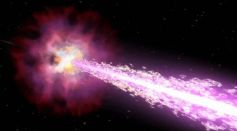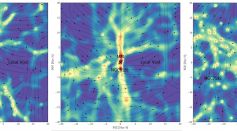Tags: Dark matter

What Is Dark Matter? Here are the Top 5 Unanswered Questions About the Largest structure in the Universe
Ancient Hawai’ian Lava Caves Home to Various Microbes Harboring Toxic Materials, Gases

How Have Halo Nuclei Contributed to the Discovery of Dark Matter? Here’s What Finding of Interesting Physics Reveals

$60 Million Project With Specialized Detector LUX-ZEPLIN (LZ) to Find Dark Matter Already Operating in South Dakota

Dark Matter Evidence: ‘Anti-Universe' Running Backward Through Time and Mirrors Our Cosmos Might Exist

Do Smaller Galaxies Lose Their Dark Matter on Collisions? Here’s What Experts Say

Dark Matter Secrets Revealed: Scientists Discover 12 Streams of Stars in Milky Way Galaxy

Dark Matter Could Be Made of ‘Scalar Bosons;’ Researchers Contend in New Research
Weird Galaxy Without Dark Matter Baffles Astronomers As It Contradicts Popular Beliefs About the Universe
Mystery of ‘Double Galaxy’ After 8 Years; Dark Matter Most Likely The Culprit, Scientists Say
Dark Energy Detected? Unexplained Finding Shows This Comprise 68% of the Universe While 27% Is Dark Matter

Dark Matter Mystery Unveiled? Scientists Set Up Rigs to Uncover Subatomic Collisions
Quantum Physics: How Quantum Crystals from NIST Could Be Used as Dark Matter Sensor
NYU Research Shows Earth's Prehistoric 'Heartbeat' Coincides with Mass Extinction Event
Hubble Space Telescope Finds A Galaxy That Lacks Dark Matter
Sagittarius A* Might Not Be a Black Hole After All, Hints Toward Dark Matter Mass

New Dark Matter Map of Universe Could Prove Albert Einstein's Theory of Relativity Wrong
Dark Matter Origin Still a Mystery: Is It More Than a Cosmic Anomaly?
Largest, Most Accurate Image to Date of the Universe Mapped by Dark Energy Survey

Cosmic Map Reveals Dark Matter Distribution and Filamentary Galactic Bridges
Most Popular

How AI Is Used in Weather Prediction: Smarter Forecasting Through Machine Learning

The Future of Clean Tech: Exploring the Next Generation of Renewable Energy Breakthroughs

De-Extinction vs. Conservation Science: Which Approach Protects Biodiversity Most Effectively?

Geoengineering and Climate Intervention Science: Can We Really Engineer a Cooler Planet?





